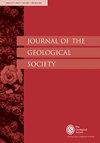Structural styles of the Tierra del Fuego fold-thrust belt foothills, Argentina
IF 3
3区 地球科学
Q2 GEOSCIENCES, MULTIDISCIPLINARY
引用次数: 0
Abstract
Regional structural cross-sections based on seismic, borehole and surface data portray the foothills geometry of the Tierra del Fuego fold-thrust belt. Andean contraction was accommodated by two main deformation mechanisms: 1) A lower duplex thrust system that involves mainly Cretaceous deposits, with floor and roof thrusts at the base of the Cretaceous and close to the base of the Cenozoic, respectively; and 2) A series of detachment and faulted detachment anticlines in the Cenozoic, detached in mudstones above the roof thrust of the underlying duplex thrust system. Less common structures include fault bend and fault propagation folds. Basement fault reactivation is only locally important, with most Jurassic grabens and half-grabens preserved without inversion. Shortening along the foothills is modest, with values ranging from ∼8 to 4.6 kilometers. This region of the fold-thrust belt has hydrocarbon exploration interest; however, it is largely underexplored. Several large anticlines preserving Cenozoic clastic rocks have not been tested to date. The key risk for these structures is the charge, as the thick mudstone package forming their detachment isolates potential Cenozoic reservoirs from the Lower Cretaceous source rocks. Duplex thrust systems at depth may constitute a potential exploration play, provided brittle intervals were naturally fractured.阿根廷火地岛褶皱冲断带山麓的构造样式
基于地震、钻孔和地表数据的区域结构横截面描绘了火地岛褶皱逆冲带的山麓几何形状。安第斯山脉的收缩是由两种主要的变形机制调节的:1)主要涉及白垩纪矿床的下双重逆冲系统,底板和顶板逆冲分别位于白垩纪底部和靠近新生代底部;(2)新生代的一系列拆离和断裂拆离背斜,在下伏复式逆冲体系顶部逆冲之上的泥岩中分离。不太常见的构造包括断层弯曲和断层传播褶皱。基底断层复活只是局部重要的,大部分侏罗系地堑和半地堑都没有反转。沿着山麓的缩短是适度的,数值从~8到4.6公里不等。褶皱冲断带的这一区域具有油气勘探价值;然而,它在很大程度上没有得到充分开发。迄今为止,尚未对几个保存新生代碎屑岩的大型背斜进行测试。这些构造的主要风险是电荷,因为形成其分离的厚泥岩包裹将潜在的新生代储层与下白垩系烃源岩隔离开来。如果脆性层段自然断裂,那么深层的双重逆冲系统可能构成潜在的勘探区块。
本文章由计算机程序翻译,如有差异,请以英文原文为准。
求助全文
约1分钟内获得全文
求助全文
来源期刊

Journal of the Geological Society
地学-地球科学综合
CiteScore
6.00
自引率
3.70%
发文量
68
审稿时长
6-12 weeks
期刊介绍:
Journal of the Geological Society (JGS) is owned and published by the Geological Society of London.
JGS publishes topical, high-quality recent research across the full range of Earth Sciences. Papers are interdisciplinary in nature and emphasize the development of an understanding of fundamental geological processes. Broad interest articles that refer to regional studies, but which extend beyond their geographical context are also welcomed.
Each year JGS presents the ‘JGS Early Career Award'' for papers published in the journal, which rewards the writing of well-written, exciting papers from early career geologists.
The journal publishes research and invited review articles, discussion papers and thematic sets.
 求助内容:
求助内容: 应助结果提醒方式:
应助结果提醒方式:


